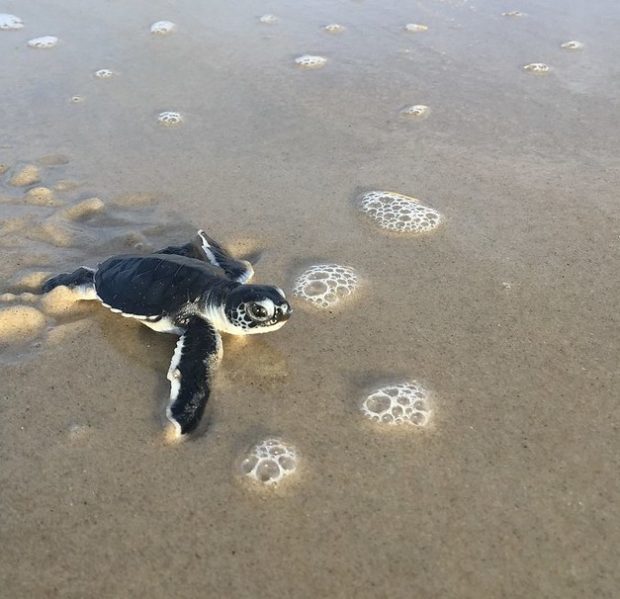Sea turtle nesting season is in full swing at Cape Hatteras National Seashore! Last month, we introduced you to Paul Doshkov, Supervisory Biological Technician (Bodie Island) and Scientific Research and Collecting Permit Coordinator at Cape Hatteras National Seashore, who answered your questions about sea turtle nests. This month, Paul answers your questions about sea turtle hatchlings!
What type of sea turtles will hatch from the nests?
Sea turtles nest on average three times per season, but only every two or three years. There are nests on our beaches every year, but not from the same sea turtles as the year before. The most common species of nesting sea turtle at Cape Hatteras National Seashore is the Loggerhead. We do get occasional Green sea turtle nests and rarely, a Leatherback or a Kemp’s ridley.
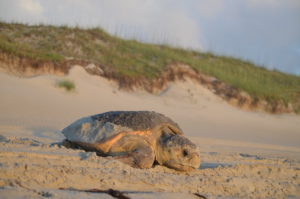
A Loggerhead sea turtle makes her way back to the ocean after laying her nest on the beach. Photo: NPS/P. Doshkov.
Do sea turtles hatch on a full moon?
Sea turtles usually hatch at night, and they are not dependent on the moon phases. In fact, they can hatch on a moonless, cloudy night and make it to the ocean. Moonlight has little effect on their senses because they are sensitive to the light that is near the horizon. Ideally, hatchlings will move toward the white caps on the waves breaking on the shore. National Park Service staff installs black filter fencing around sea turtle nests to keep out light from houses, buildings and off-road vehicles that could disorient the hatchlings.
Do sea turtle hatchlings stay together once they emerge from their nests?
Once they emerge, they disperse and are on their own.
How do sea turtle hatchlings know how to get to the ocean once they emerge from their nests?
Hatchlings find the sea because the sky is slightly brighter over the water than the land. If you are walking along Cape Hatteras National Seashore at night and see hatchlings repeatedly going the wrong direction, shine a small flashlight close to the ground in front of the hatchlings to lead them to the surf. Never shine the light directly at the hatchlings. Other navigational cues include slopes in the sand and the sound of the surf.
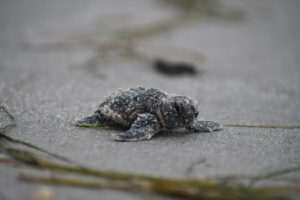
A loggerhead sea turtle hatchling covered in sand sits on the beach on Cape Hatteras National Seashore. Photo: NPS/B. Ranelli.
What threats do sea turtle hatchlings face when they try to reach the ocean?
Hatchlings are approximately two inches long when they emerge from their nests. On the beach, they are subject to depredation from both animals and people.
Dogs off leash have been known to dig into sea turtle nests. If a dog is loose when the hatchlings emerge, it may chase the hatchlings and injure them. Coyotes and/or raccoons will dig up nests and eat the eggs or hatchlings. Ghost crabs will also burrow into nests to eat eggs during the incubation period.
People have walked in or driven through nest enclosures, and the weight of stepping on or driving over the nest can compact the sand, making it difficult or even impossible for the hatchlings to dig out of the nest. Unnecessary handling of hatchlings can cause injury and may pass organisms from a person’s skin to the hatchlings, causing illness.
Once hatchlings reach the ocean, they face predation from pelicans, terns, gulls and fish.
What do sea turtle hatchlings eat?
Hatchlings are born with a three-day supply of food in a yolk attached to their bellies which should last until they get to their feeding grounds in the Gulf Stream. Hatchlings are opportunistic; once they reach adolescence, their feeding habits become more specialized.
Loggerhead sea turtles eat shellfish and crabs. Green sea turtles have a diet consisting of algae and seagrasses, as well as green and red algae, jellyfish, salps and sea sponges. Leatherback sea turtles eat jellyfish and colonial siphonophore (e.g., Portuguese Man-O-War and tunicates).
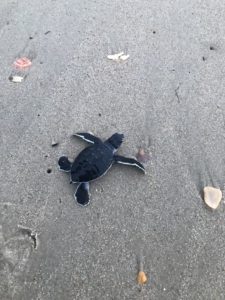
A green sea turtle hatchling crawls on the sand on Cape Hatteras National Seashore. Photo: NPS.
Where do sea turtle hatchlings go when they reach the ocean?
For the first few days, they swim out to sea eating small ctenophores and larval shrimp and crabs. Offshore, they swim only a few hours at a time. They rest most of the time and float with the current.
Loggerhead sea turtles swim to the Gulf Stream and they find Sargassum seaweed islands where they forage and hide. The North Atlantic Gyre sweeps them up, and then the current takes them to coast of Portugal, then south to Azores, Canary Islands and Cape Verde Islands off the West Coast of Africa and finally westward and brings them back to the eastern United States. This journey takes years to complete, and they eventually end up in the Sargasso Sea.
Green sea turtles ride the North Atlantic Gyre but spend less time in it than Loggerheads. The color of their body suggests they are open-water animals and do not hide in Sargassum mats.
Leatherback sea turtles swim during the day for at least the first six days and rest at night. Then they disappear and are not seen again until anglers in the open ocean catch them. They are about three years old at that time with their carapaces measuring 30 inches.
How do sea turtle hatchlings know where to go?
Hatchlings have magnetite, an iron compound that aids them in detecting the earth’s magnetic field, in their brains. This helps them one day navigate back to their natal beach to nest.
How can we help protect sea turtles and hatchlings?
The World Conservation Union (IUCN) internationally recognizes Loggerhead and Green sea turtles as endangered and Leatherback sea turtles as critically endangered. Under the United States Federal Endangered Species Act, Leatherbacks are endangered, Loggerheads are threatened, and Greens are threatened except in the breeding populations in Florida and Mexico’s Pacific Coast where they are listed as endangered.
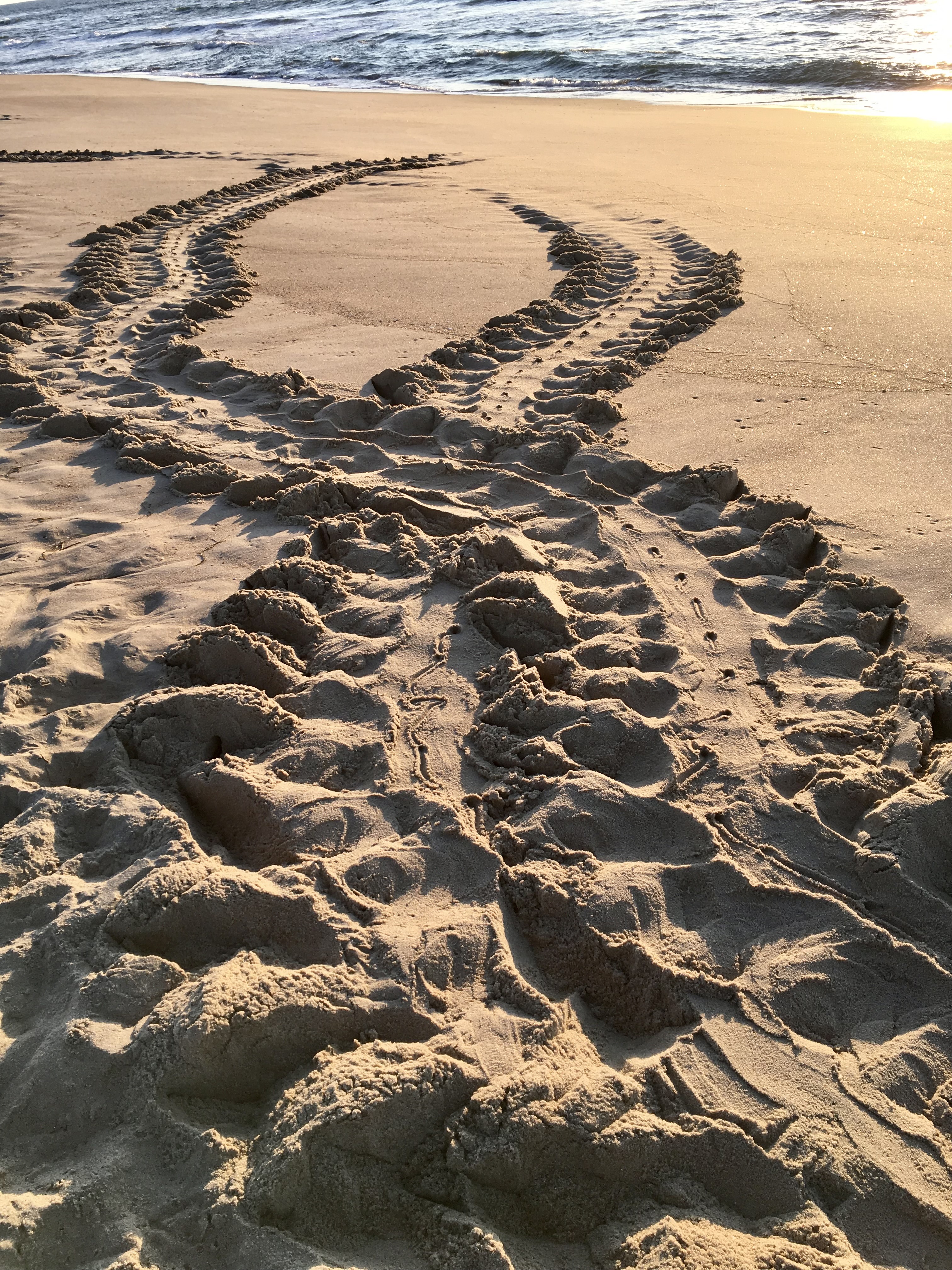
Green sea turtle crawl tracks in the sand on Cape Hatteras National Seashore. Photo: NPS.
Make sure to take all your equipment (e.g., canopies, volleyball nets, folding chairs, umbrellas) and trash with you when you leave the beach daily. Sea turtles and hatchlings can mistake plastic bags, balloons, Styrofoam, plastic bottles and rope for food and eat them, which causes intestinal blockages. Additionally, sea turtles and hatchlings can easily become entangled in woven bags, fish nets, lobster or crab pot lines, fishing lines, six-pack yokes, steel cables, burlap bags, sheeting and beach chairs. If you dig a hole in the sand, fill it in. A hole left on the beach poses a danger for sea turtles and hatchlings that are making their way to the ocean.
If you come across an injured, sick, or deceased sea turtle or sea turtle hatchling or a damaged sea turtle nest, please call the Cape Hatteras National Seashore Stranding Hotline at (252) 216-6892 and refrain from touching the sea turtle, hatchling or nest.
To learn more about the sea turtles that call Cape Hatteras National Seashore home, click here.
About Paul
Paul has served as a Biological Science Technician at Cape Hatteras National Seashore for 15 field seasons and is primarily involved with shorebird management, sea turtle management and marine mammal (whales, dolphins, porpoises, seals and the occasional manatee) stranding coordination including seal observations during the winter months. Paul is based out of Nags Head near Coquina Beach and has also recently begun coordinating the Seashore’s Research and Collecting Permit program. For any interest in conducting research on the Seashore, please contact Paul at paul_doshkov@nps.gov.

